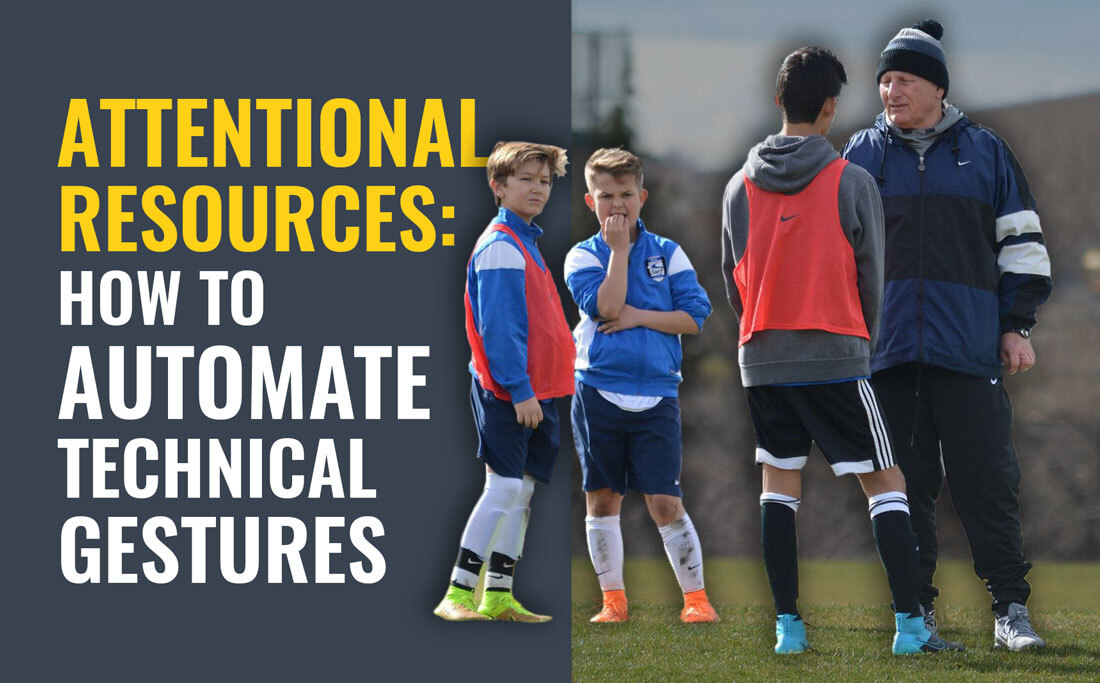Attentional resources: how to free them up in order to automate technical gestures
Goal

|
Technical training methodology for Youth Academy |
Modern soccer causes young players to have more and more external solicitations, more complexity and responsiveness on the pitch and with feedbacks. It is more important than ever to train technical, tactical and athletic skills with greater attention to cognitive-mental aspects. Coaches need to focus on attention.
Attention could be considered as a process that regulates mental activity by filtering and organising external information in order to get an adequate response (in the best and quickest way!).
ATTENTION can be classified as:
- MAINTAINED (fundamental to keep the attention focused on the ball during the game).
- DISTRIBUTED (necessary to understand possible game evolutions while keeping an eye on the most part of the perceptual field).
- SELECTIVE (to classify which stimuli to prioritize above the others in order to choose how to solve a situation).
- FOCUSED (to focus the attention as effectively as possible on a particular choice) - "SPECIFIC VISUAL FOCUS"
All attentional modes are governed by a sort of "central processor" that scientific literature calls SUPERVISORY ATTENTIONAL SYSTEM (SAS).
Coach's responsibility is to train SAS with multiple and progressive stimuli during each workout.
EXAMPLE
Let's say there is a soccer player who passes the ball to a teammate; once they automate the gesture, they draw very few energy from SAS. But if we add a rival nearby that is trying to prevent the pass, the player will have a much more complex task with two possible options (the pass and the attack). In this scenario they can't perform in automation and will need SAS intervention (moving from a distributed attention to a selective and focused one in an instant)!

WHICH METHODOLOGY?
To solve a situation during the game we need to create an as complete as possible educational path:
| ANALYTICAL DRILL (1) | ⇒ | COMPLEX DRILL (2) | ⇒ | INTEGRATED DRILL (3) |
| (es. TECHNICAL GESTURE) | (es. APPLIED TACTICS) | es. THEMED TRAINING GAME |
- In a didactic progression, it is important (in the beginning) to teach basic motor skills in order to automate fundamental technical and coordinative abilities. This can be done through 3 main routes:
- Perform the movement
- Observe the correct movement performed by others
- Focus the attention on known motor skills
- One learned and automated a technical motor skill, the coach can enrich players' wealth of knowledge by adding variations and external stimuli, creating specific more complex drills that involve SAS.
- Lastly, the educational path must be integrated with elements and drills that are closer to the game. Players should learn through realistic conditions.
CONCLUSIONS
In a soccer environment that is constantly evolving, it's important to provide stimulating and emotionally involving drills; the coach should make players part of their own educational path. By providing individual tactics drills while working on techical skills, timing and spaces with intensity, you can automate gestures and free up attentive resources, creating mentally sharp kids that perform effectively during matches.
All age groups should be trained to choose the best option!
Sources: "L'essenza del calcio" by Davide Brunello, Notiziario del Settore Tecnico, 2012.
































































